Colorful Indoor Plants: Colorful Leafy Plants (Red, Pink, Purple, White) – With Pictures
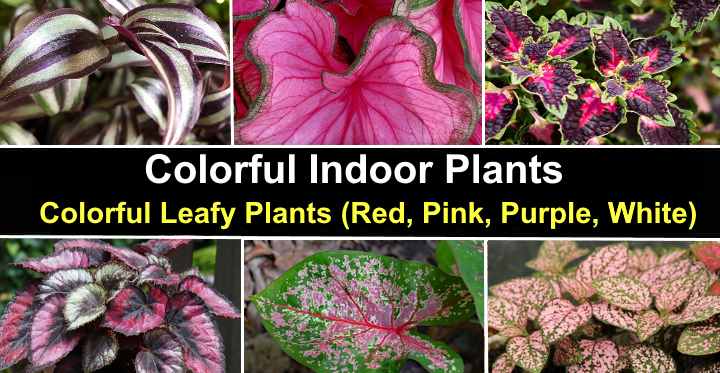
Colorful plants with red, pink, green, purple, or white leaves add exotic beauty to any interior décor. Colorful leafy plants provide year-long interest without the need for flowers. Although some houseplants with colorful leaves bloom, their interest is with their multi-colored foliage. The best thing about growing colorful plants is that they are typically easy-to-care-for indoor plants.
Colorful foliage houseplants come in many color combinations. For example, tropical alocasia plants have striking glossy dark green and white leaves. Caladium plants have bi-colored and multi-colored leaves that can be red and green, pink and green, or shades of red, white, and green. Some compact houseplants such as nerve plants or polka dot plants have small leaves that are green and red, green and white, or have pink blotches on green leaves.
Whether you want to make a dramatic statement with stunning white and green leafy plants or add pastel-colored foliage plants, you will find plenty of colorful indoor plants for your home.
This article is a complete guide to eye-catching colorful houseplants that are easy to grow. Descriptions and pictures of vibrantly-colored leafy plants will help you choose which ones to grow at home.
Plants with Colorful Leaves (With Pictures)
Do you want to add a splash of year-long color to your home’s interior? Would you like to know about colorful houseplants that don’t need flowers to look stunning? If so, please read on to find out more about colorful leafy plants.
Coleus
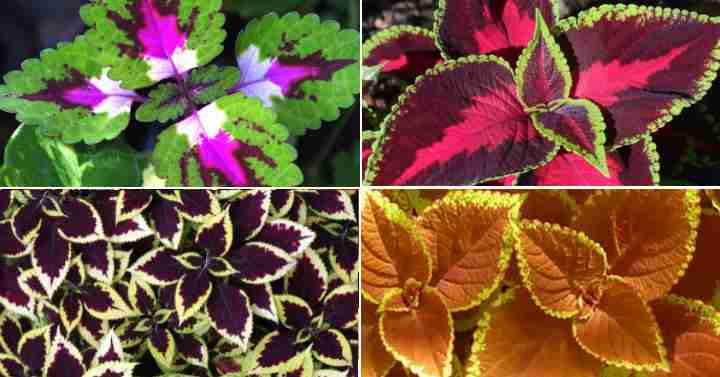
Coleus are colorful houseplants that come in a stunning array of color combinations
Coleus is a low-growing tropical plant with fuzzy leaves in dazzling colors. Also called Solenostemon, coleus plants have colorful ovate leaves with serrated edges. Some coleus plants have leaves with bright pink, burgundy, and lime green colors. You’ll also find coleus houseplants with green and purple or translucent green and red colors.
Some stunning examples of colorful coleus foliage are the single-colored varieties. For example, some showy coleus plants have deep pink or red leaves, bright yellowish-green leaves, or deep purple, almost black leaves.
Coleus plants grow best indoors in loose, well-draining soil and in bright, indirect sunlight. The only care that coleus plants need is some watering when the soil is partially dry. Even when growing in the shade, coleus plants don’t lose the vivid colors on the leaves.
Further reading: Coleus Care: How to Grow Colorful Coleus Plant Indoors and Outdoors.
Nerve Plant (Fittonia)
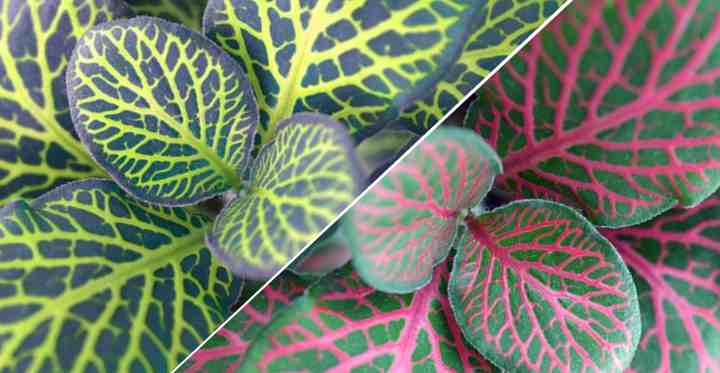
Nerve plants have colorful foliage to add ornamental touch to your home decor
Nerve plants are small tropical ornamental plants with dark green oval leaves that have vibrantly-colored network patterns. Also called mosaic plants, Fittonia cultivars have leaves with vivid red, bright pink, white, or reddish-purple veins. The coloring on some nerve plants is so bright that the leaves appear bright pink, not dark green.
Nerve plants only grow about 4” (10 cm) tall and have a spread of around 9” (23 cm).
The compact, low-growing nature of nerve plants means they combine well with other plants. You can grow these bedding plants in containers with taller flowering plants. The fascinating colorful leaves add plenty of interest together with orchids, calatheas, or bird’s nest ferns.
Because they prefer warm, humid environments, nerve plants are ideal plants for closed terrariums. You can also grow nerve plants on a bright windowsill, protected from direct sunlight.
Further reading: Nerve Plant (Fittonia Plant): Caring for Vein Plants.
Polka Dot Plant (Hypoestes phyllostachya)
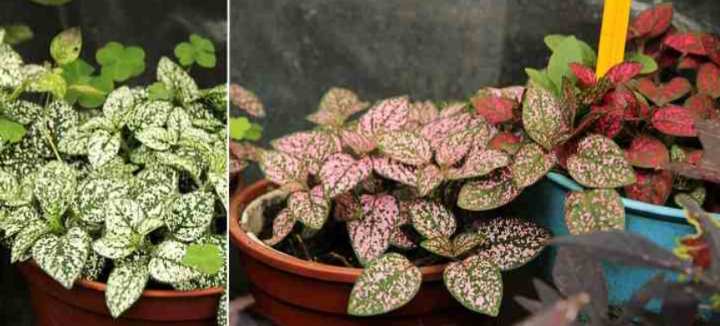
Polka Dot indoor plants have colorful splashes on the green leaves in shades of pink, red and creamy white
Polka dot plants are cute ornamental houseplants with dark green, ovate leaves with splashes of red, pink, white, or bright green. Due to the colorful leaf markings, these compact plants are also called splash plants and freckle face plants. The brightly colored polka dot leaves can have a few spots of color, or they can be heavily mottled.
Polka dot plants with their colorful leaves are in the same tropical plant family (Acanthaceae) as nerve plants. Polka dot plants grow up to 12” (30 cm) tall and have leaves larger than nerve plants. To grow polka dot plants at home, keep them in a humid environment and partial sun.
Further reading: Polka Dot Plant (Hypoestes Phyllostachya): Care and Growing Tips.
Poinsettias (Euphorbia pulcherrima)

Poinsettia plants have showy red and green leaves
Poinsettia plants are colorful potted plants with brightly colored red bracts that look like leaves. The stunning red colors contrast with the dark green lance-shaped leaves. Apart from the vibrant red leaves, poinsettia cultivars can have cream, yellow, orange, or pale green leaves (bracts).
Because the red and green leaves are usually most dramatic around midwinter, the plant is also called the Christmas star or Christmas flower. The fiery red leaves give the plant common names such as Mexican flameleaf and fire plant.
Although poinsettia is a blooming plant, it rarely flowers indoors. If the plant flowers, the blooms are insignificant compared to the colorful red, cream, or yellow leaves.
Poinsettia plants grow best as a houseplant in bright, indirect light, semi-cool temperatures, and moderate humidity.
Ti Plant (Cordyline fruticosa)
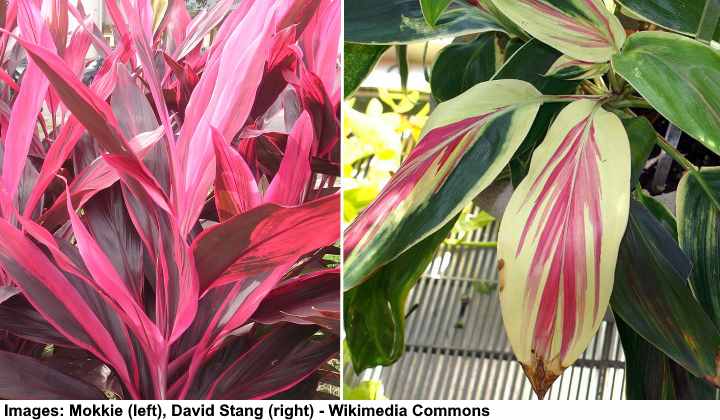
The variegated leaves of Ti plants come in beautiful color combinations and shapes
The Ti plant is a tropical plant with showy colorful foliage in shades of purple, pink, white, or cream. Some of the most stunning Ti plants have variegated purple leaves with white or hot pink streaks. As long as it gets enough light, Ti plant leaves keep their extravagant colors throughout the year.
Ti plants are also called the good luck plant, cabbage palm, or palm lily.
There is a vast variation among the leaf shapes and colors. Some cultivars have elongated lanceolate green leaves with bright pink margins. Other cultivars have yellowish-orange leaves with strokes of reds and pinks. One eye-catching houseplant, the ‘Red Sister,’ has variegated green and pink leaves.
The Ti plant is a non-blooming potted plant that needs plenty of bright light indoors to keep the color-packed foliage vibrant.
Canna Lily (Canna indica)
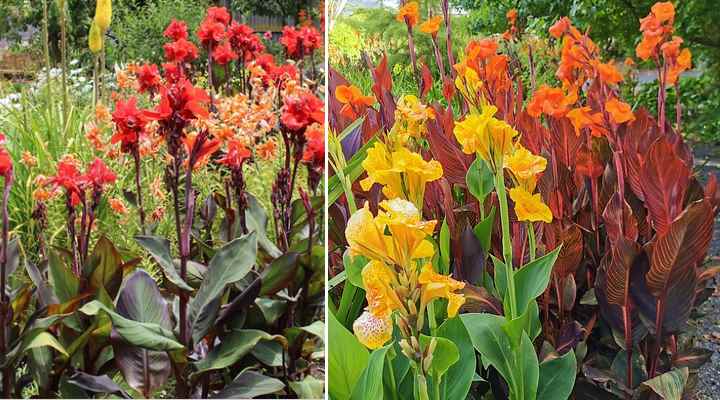
Canna lilies are tall plants that can be grown indoors during winter in the sunniest location in your home
The canna lily is a tall, broadleaved exotic plant with beautiful flowers and stunning large leaves. Although canna lilies generally have attractive green leaves, some cultivars are prized for their variegated leaves.
You’ll find canna lily plants with beautiful bronze leaves with purple and yellow stripes among the plant cultivars. Other canna lily cultivars have bold, dramatic foliage with huge chocolatey-brown leaves.
Canna lilies are beautiful flowering foliage plants for patios, decks, and backyards. During winter, you can bring the pots indoors to keep the plant blooming throughout the year.
Colorful Aglaonema
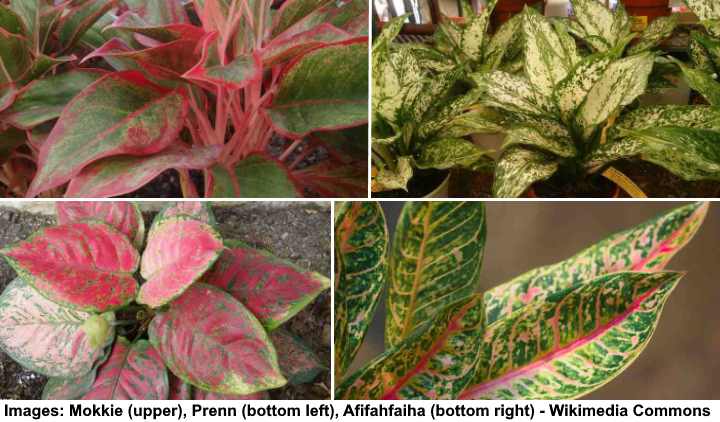
Aglaonema cultivars have colorful leaves in shades of green, red creamy-yellow and white
Aglaonema plants are easy-to-grow houseplants that are prized for their colorful green, red, pink and cream foliage. The shiny green leaves have splashes of pink, white, or red colors. Some varieties have pointed lance-shaped glossy green leaves with contrasting red or pink veining.
The most spectacular aglaonema plants have red and green variegated leaves. For example, the ‘Siam Aurora’ (red aglaonema) has large green leaves with hot pink or red margins. Or there are aglaonema cultivars with bright red pointed leaves and thin green edges. If you are after colorful plants with white and green leaves, then the ‘White Calcite’ has green lanceolate leaves with white spots.
To care for colorful aglaonema plants, grow them in bright indirect sunlight and water when the top part of the soil is dry.
Further reading: Aglaonema Care: How to Grow Chinese Evergreen.
Calathea
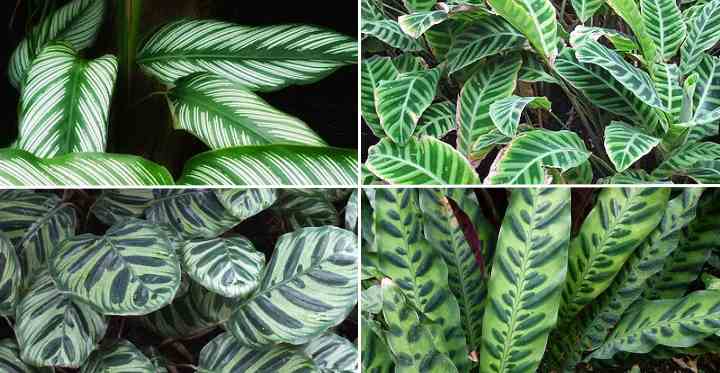
Calathea cultivars have green and white leaves in a wide array of patterns with purple undersides
Calathea plants are grown indoors for their stunning white and green tropical foliage rather than their flowers. Calathea cultivars have exotic green leaves with patterns that can be white, lime green, or dark green. Calathea leaves can be green oval leaves with white markings, light green lanceolate leaves with dark green patterns, or large green leaves with white pinstripes.
One of the stunning features of calathea leaf colors is their purple undersides. Turning a leaf over reveals dark shades of burgundy or reddish-purple. These colors also are visible when the leaves rise at night like many species of prayer plants.
Because calathea plants are native to tropical rainforests, they grow well in average room temperatures, with high humidity and partial shade.
Related reading: Calathea: Types, Care and Growing Tips.
Caladiums
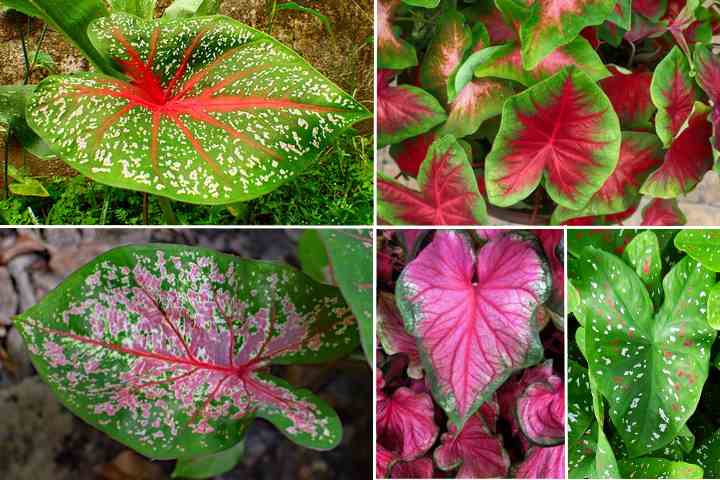
The beautiful color combinations of caladium leaves add decorative touch to your home
Caladium plants have some of the most spectacular colorful leaves from any houseplant. The fancy-shaped or strap-shaped green leaves have vivid pink, red, white, and multi-colored patterns. A feature of caladium leaf color is the brightly colored veins contrasting with the heart-shaped green leaves.
Caladium plants are also called elephant ears, angel’s wings, and the heart of Jesus. Although they are related to Alocasia plants, caladiums have more colorful foliage and vibrant multi-colored leaves.
The most colorful caladium plants are cultivars of the species Caladium bicolor. You will find spectacular foliage plants with leaves in heart or arrow shapes. Some leaf color combinations include bright pink and green, white, red, and green, and green with white and red dots.
One stunning caladium cultivar has bright pink leaves, dark red veins, and green margins.
Related reading: The best way to care for caladiums.
African Mask Plant (Alocasia)
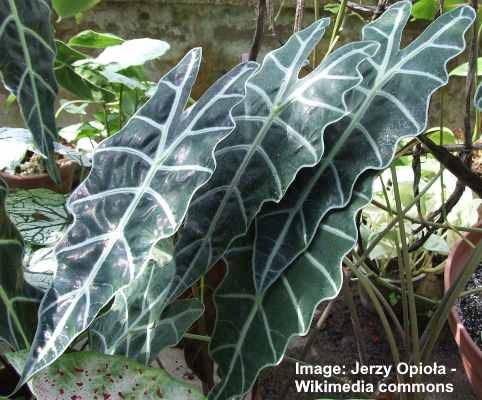
Alocasia Amazonica (in the picture) and it’s compact cultivar ‘Polly’ have unusual green leaf shape with pronounced white veins
The African mask plant is a species of Alocasia with shiny green foliage and dramatic thick white veins. African mask plants are indoor tropical plants with arrowhead leaves. The huge, pointed tropical white and green leaves usually have wavy margins and downward growth.
The best type of African mask plant to grow indoors is the Alocasia amazonica ‘Polly.’ This compact tropical potted plant grows up to 2 ft. (0.6 m) tall. The eye-catching foliage with its green glossy pointed leaves and contrasting white veins add a tropical touch to any home interior.
Related reading: The best way to care for Alocasia plants.
White Lungwort (Pulmonaria)
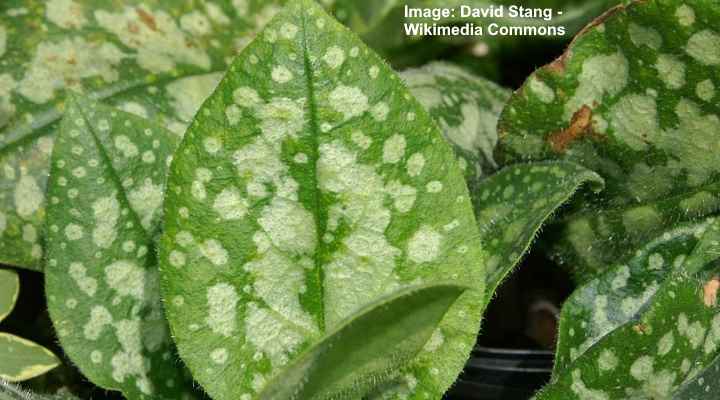
Pulmonaria ‘Sissinghurst White’ has green leaves with white or pale green splashes
White lungwort is a shade-loving plant species with green, ovate leaves with small white or light green blotches. The ‘Sissinghurst White’ cultivar has clumps of white-spotted green leaves growing at the end of long stems. The ornamental plant comes into life in spring when delicate white flowers appear.
Arrowhead Vine (Syngonium podophyllum)

Arrowhead vine plants are popular indoor plants with colorful foliage and interesting leaf shape
The arrowhead vine plants have heart-shaped leaves with delicate shaded light pink and green leaves. The dusty pink shading on papery green leaves adds subtle pastel shades to an interior’s décor. As an indoor vining plant, the arrowhead vine grows up to 5 ft. (1.5 m) long.
Apart from the light pink and green variegated arrowhead plant, other cultivars have yellow and orange leaf shades. There’s also an arrowhead vine cultivar with green leaves and yellowish-white network patterns.
Arrowhead vines are also called goosefoot plants, arrowhead philodendrons, and American evergreen.
Further reading: Syngonium Care – How to Grow Arrowhead Plant.
Rex Begonias (Begonia rex cultorum)
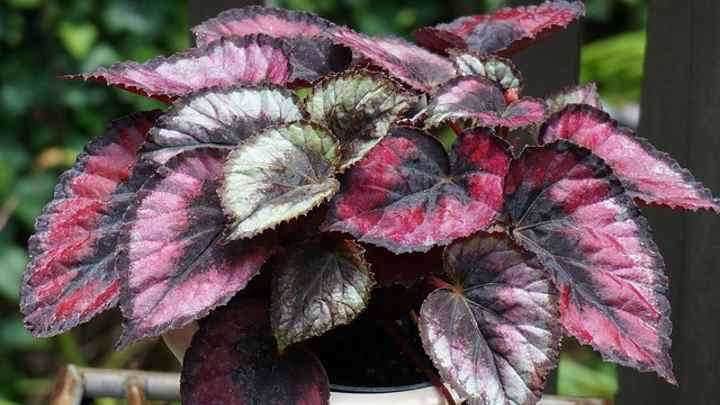
Rex begonia is a small houseplant with attractive leaf color patterns
Rex begonias are low-growing colorful foliage plants with many variations of leaf colors. It’s not just the colorful leaves that make rex begonias popular. The tropical houseplants have unusually-shaped leaves with attractive color patterns. Because these plants are relatively compact, their colorful leaves help brighten up small spaces.
The leaves on rex begonias range from white-spotted green lanceolate leaves to dramatic red and black triangular leaves. Other colors found on rex begonia leaves include reddish-green, silvery-green, pink and green, bronze and silver, and dark green with hints of white, silver, bronze, and purple.
To grow rex begonias indoors, grow the potted plants in medium light and well-draining soil.
Wandering Jew (Tradescantia zebrina)
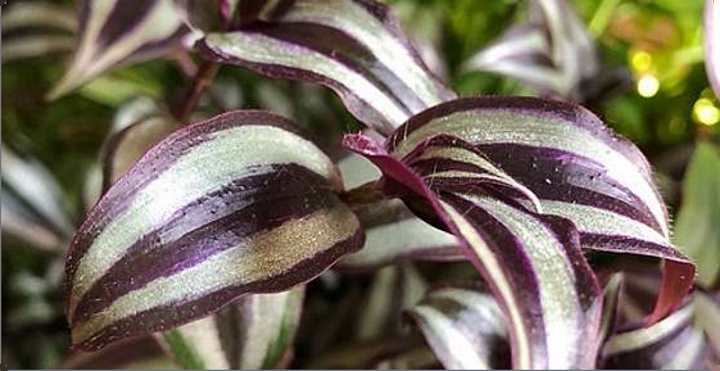
Also called the silver inch plant, the wandering Jew has striped, green, silver, and purple pointed leaves. This trailing evergreen tropical plant grows long dangling stems that are covered in colorful lanceolate-shaped leaves. The attractive purple and green foliage looks stunning, dangling from hanging baskets.
Another name for the wandering Jew is spiderwort. This hanging basket plant is easy to grow and propagate for a colorful indoor accent. With regular pruning, you can also grow the silver inch plant as a tabletop houseplant.
Vase plant (Aechmea fasciata)
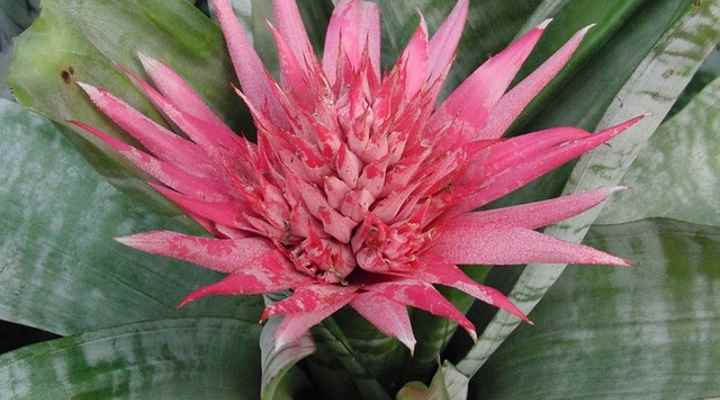
Vase plants have silvery green leaves with colorful pink bracts that add tropical look to home decor
The vase plant is a type of bromeliad that has silvery-green arching leaves. The tropical plant comes to life when a spectacular colorful rosette of green, pink, or purple-colored leaf-like bracts develop in the plant’s center. The bright pink, purple, or variegated yellow and green leaves and purple flowers can last for months.
The vase plant is also called the urn plant or silver vase plant due to its growth and color of leaves. The vase plant grows up to 20” (50 cm) tall. Because they are a type of air plant, vase plants require little water in the soil. However, this unusual houseplant requires water in the central vase.
Persian Shield (Strobilanthes dyerianus)
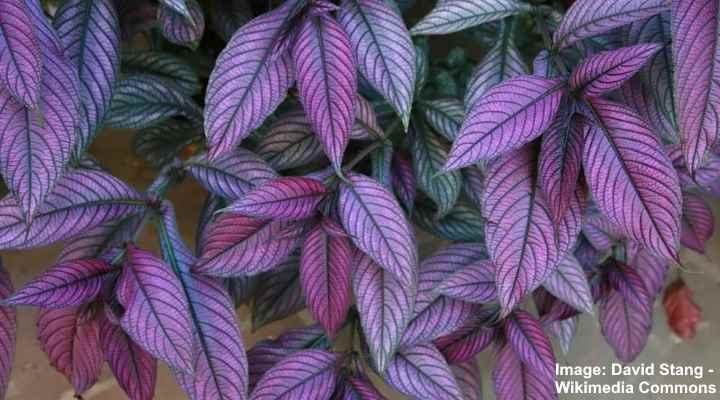
Persian Shield has stunning purple and green leaves and grows well in medium indirect light
If you’re looking for a tropical houseplant with stunning purple colors, then the Persian shield is an excellent choice. Also called the royal purple plant, the Persian shield has pointed lanceolate leaves that are dark green with shiny purple iridescent colors. The metallic purple striped pointed leaves grow out from a central leaf vein.
Grow Persian shield as a houseplant in medium light, but always protected from direct sunlight.
Purple Passion Plant (Gynura aurantiaca)
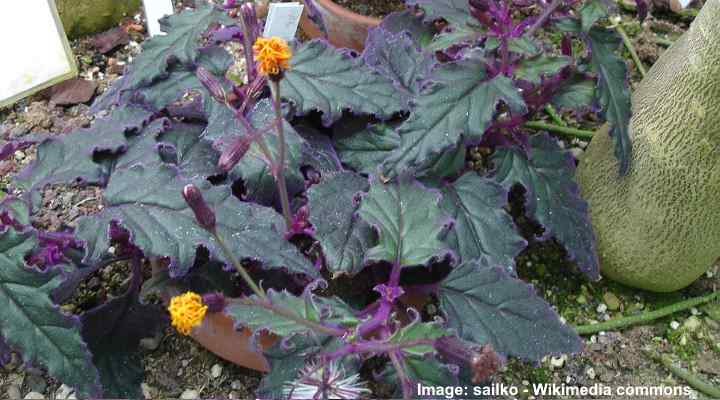
The green and purple leaves of purple passion plant contrast nicely with its small orange flowers
The purple passion plant is a low-growing tropical plant with dark green leaves and purple undersides. Also called the velvet plant, in temperate climates, this plant grows as a colorful houseplant. Its dark green stems and leaves are covered with purple hairs, giving the plant a velvety feel.
One of the attractive features of this purple foliage plant is the orange flowers that bloom on the end of long stems. This unusual color combination of purple, orange, and green creates an eye-catching potted plant for any brightly-lit room.
Croton (Codiaeum variegatum)
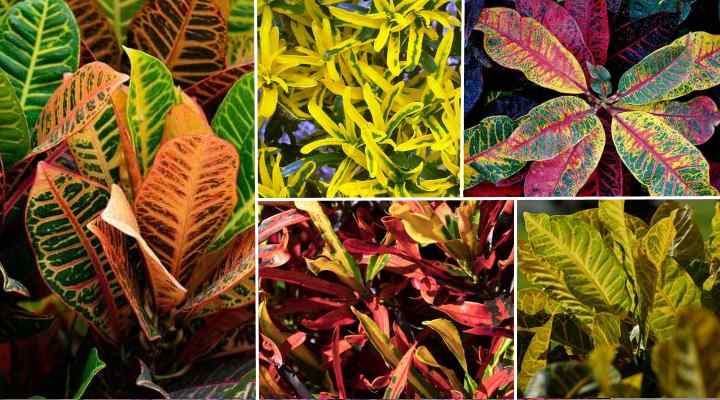
Croton plants have various leaf shapes and variegation with red, orange, yellow and green colors
Croton is a tropical species of plant with colorful green, red, yellow, and orange leaves. There are many color variations on the unusually-shaped leaves. The most common leaf variegation is varying patterns of green and yellow with hints of orange. Some of the most stunning colorful croton leaves are bright red and green or red and orange.
It’s not only the colorful leaves that make croton plants popular houseplants. The leaf shapes are also fascinating. For example, the waxy leaves can be long and linear, short and ovate, deeply lobed, or have twisted margins.
The bright colors of croton houseplants also combine well with other tropical houseplants. For example, orange and red-leaved crotons look spectacular, growing alongside plants that have purple flowers. Or you could grow colorful crotons with plants that have similar-colored flowers—red, orange, or yellow.
Coral Bells (Heuchera)

You can plant multi-colored coral bells plants indoors or outdoors in partial shade
There seems to be no end to the spectacular color combinations when you see pictures of colorful ruffled foliage of coral bells (Heuchera). The small rounded lobed leaves with frilly margins grow in vibrant colors such as bright autumn orange, champagne gold, luminescent green, fiery red, and deep purple. The compact, colorful leafy plants are ideal for growing indoors or outdoors.
Some of the most stunning leaf colors in the Heuchera species are the variegated varieties. For example, some cultivars have green or yellow leaves with vibrant red veining. Other cultivars have silvery purple leaves with burgundy patterns. Or there are coral bells plants with bright green leaves and dark network patterns.
To care for multi-colored coral bells plants, grow the plants in partial shade. Although you can grow Heuchera plants indoors, it’s best to grow them in the ground in your front or backyard as colorful bedding or border plants. Coral bells are cold-hardy to USDA zone 4, so they will last through most winters exceedingly well.
Related articles:
